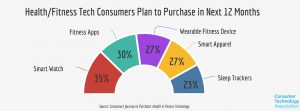
2017 tech growth exceeds expectations
Stephen Law
Automation / Robotics Electronics Production / Materials Regulations & Standards Wireless Engineering IoT Medical Printable Electronics Supply Chain Wearable Technology new techIndustry revenue to reach record levels as emerging categories soar, says CTA
Consumer enthusiasm for both emerging technology and resilient mature categories is exceeding expectations – driving the U.S. consumer technology industry to an estimated 3.2 percent revenue growth in 2017, earning $321 billion in retail revenues ($251 billion wholesale), according to new research from the Consumer Technology Association (CTA). The latest CTA industry report also projects drones, OLED TV and virtual reality (VR) technology will each cross the $1 billion revenue milestone for the first time this year.
“Driven by consumer demand for the products we already know and love, as well as new, innovative technologies, revenue growth in the consumer technology industry is exceeding expectations,” said Gary Shapiro, president and CEO, CTA. “Not only are breakthrough technologies changing our lives for the better – such as drones delivering medical supplies to remote areas or the use of VR in patient care – tech is also a key driver of the U.S. economy, outpacing GDP growth, and reinforcing America’s role as a global leader in innovation.”
CTA’s semi-annual report serves as a benchmark for the consumer technology industry, charting the size and growth of underlying product categories. The CTA consensus forecast reflects U.S. factory sales-to-dealers for more than 300 consumer tech products.
Emerging Technology Soars
Among categories tracked by CTA’s forecasts, U.S. sales of connected devices are projected to reach 635 million units in 2017 – a record high total and six percent year-over-year increase from 2016.
* Wearables: The total wearables market – including fitness activity trackers, other health and fitness devices, hearables, over-the-counter hearing devices and smartwatches – is expected to reach sales of 48 million units in 2017 (nine percent increase) and earn $5.6 billion.
* Smart Home: Harnessing the Internet of Things (IoT) to provide personalized home automation experiences, smart home is one of the most popular emerging tech categories. CTA projects sales in the category – including smart thermostats, smart smoke and carbon monoxide detectors, IP/Wi-Fi cameras, smart locks and doorbells, smart home systems, and smart switches, dimmers and outlets – to reach 27 million units in 2017 (50 percent increase over 2016), earning $3.3 billion (48 percent increase).
* 4K Ultra High-Definition (4K UHD): 4K UHD TVs are one of the industry’s fastest growing segments, far outpacing the transition to HDTV, with unit sales forecast to hit 16.7 million units (59 percent increase) generating $14.6 billion in revenue (45 percent increase).
* Digital Assistant Devices: Voice recognition technology is one of the defining trends of 2017 and these devices continue to gain popularity. 2017 unit sales projections for voice-controlled digital assistant devices – including Amazon’s Echo, Google Home and expected new market entrants like the Apple HomePod – are projected to reach 11 million units (53 percent increase) and generate $1.3 billion in revenue (22 percent increase).
* Virtual Reality (VR): Led by continued interest in mobile headsets and entertainment content, shipments of VR headsets are projected to grow to 5.3 million units (79 percent increase) and $1.3 billion in revenues (43 percent increase).
* Drones: Total drone sales are expected to reach 3.4 million units (40 percent increase) and $1.1 billion in revenue (44 percent increase) for the first time in 2017. CTA’s forecast delineates U.S. drone sales for units below and above 250 grams, the FAA’s division for mandatory drone registration: Shipments of drones below 250 grams are expected to reach just over 2 million units, while drones above 250 grams will surpass 1.3 million units shipped.
“More and more consumers are adopting connected products at a rapid pace, with several categories such as drones, VR and OLED TVs surpassing significant revenue milestones just a few years since their market entry,” said Steve Koenig, senior director of market research, CTA. “At the same time, core categories, such as smartphones and laptops, continue to experience unit and revenue growth, demonstrating resilience in mature technologies. We believe the anytime/anywhere access to information and each other that connectivity enables is a driving trend of our time.”
Maturing Technology Defy Expectations
The top five revenue categories continue to contribute just over half of total industry revenue (53 percent) in 2017. Despite some slight revenue declines, unit shipment increases demonstrate continued resilience in these categories.
* Smartphones: Continuing to defy expectations, despite widespread adoption, unit volume will grow three percent to reach 185 million smartphones shipping in 2017, with revenues expected to reach $55.6 billion (two percent increase).
* Televisions: In 2016, LCD television enjoyed record unit shipments but 2017 will initiate a period of slight declines with unit volume at 40 million units (one percent decrease) and $18 billion in revenue (one percent decrease). Future category growth will be driven by 4K UHD, high dynamic range and OLED display technology.
* Tablets: With the tremendous consumer uptake of tablets over the past few years, adoption has leveled off and replacement cycles have slowed. Tablet sales will decline in 2017, as CTA expects sales of 59 million units (five percent decrease) and revenues of $16 billion (eight percent decrease).
* Laptops: In 2017, the laptop market, including commercial and consumer channels, will sell 48 million units, up two percent over last year, and earn $28 billion in revenue (one percent decrease). Convertible models represent an area of growth.
* Automotive Technology: Joining the top five largest revenue hardware categories for the first time, factory-installed automotive technology, from driver-assist features to entertainment systems, is projected to contribute $15 billion (12 percent increase) in revenue to the industry as a result of overall automotive sales performing well, a rising tide of tech integrated into all vehicles and the increasing density of tech installed in each vehicle.

